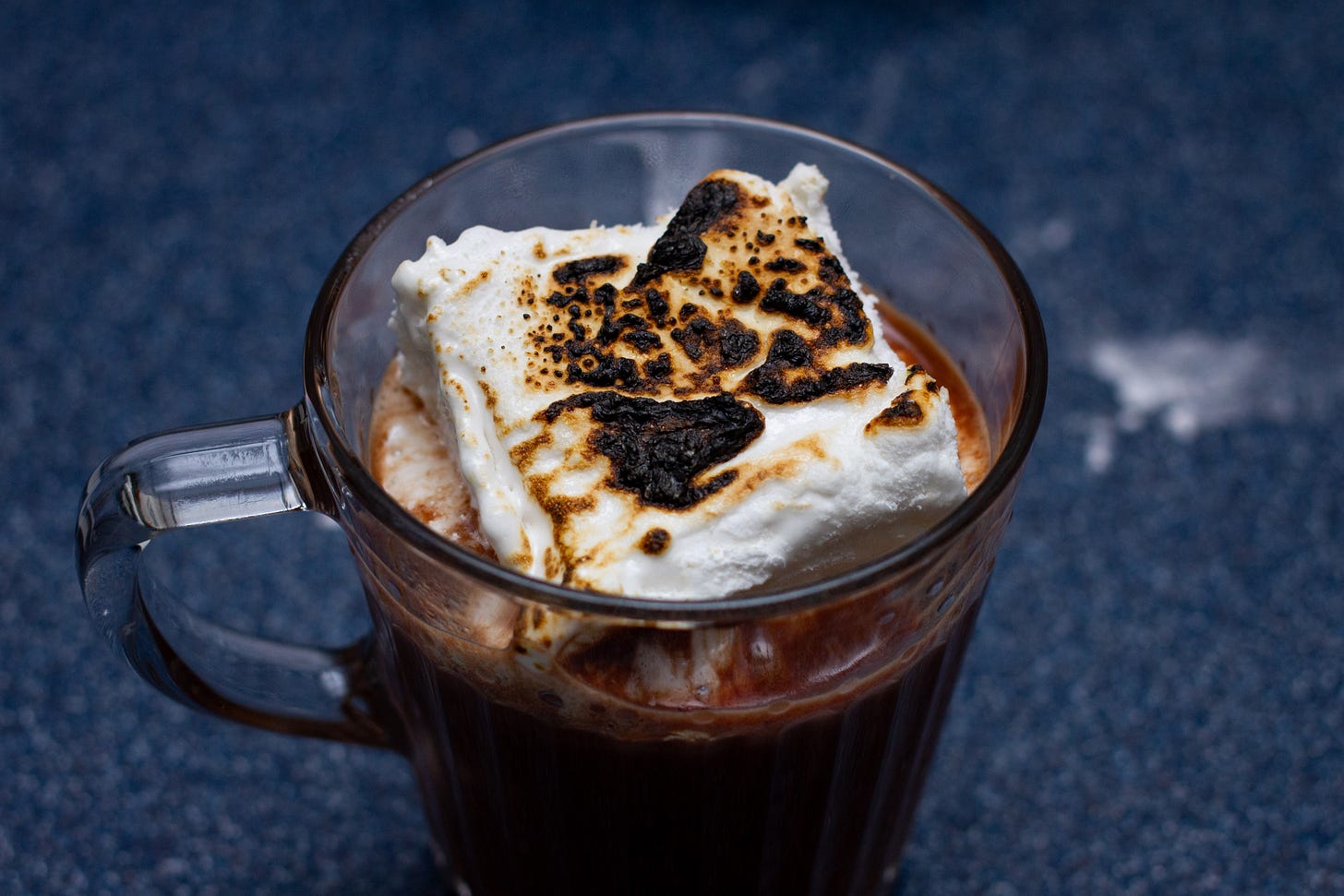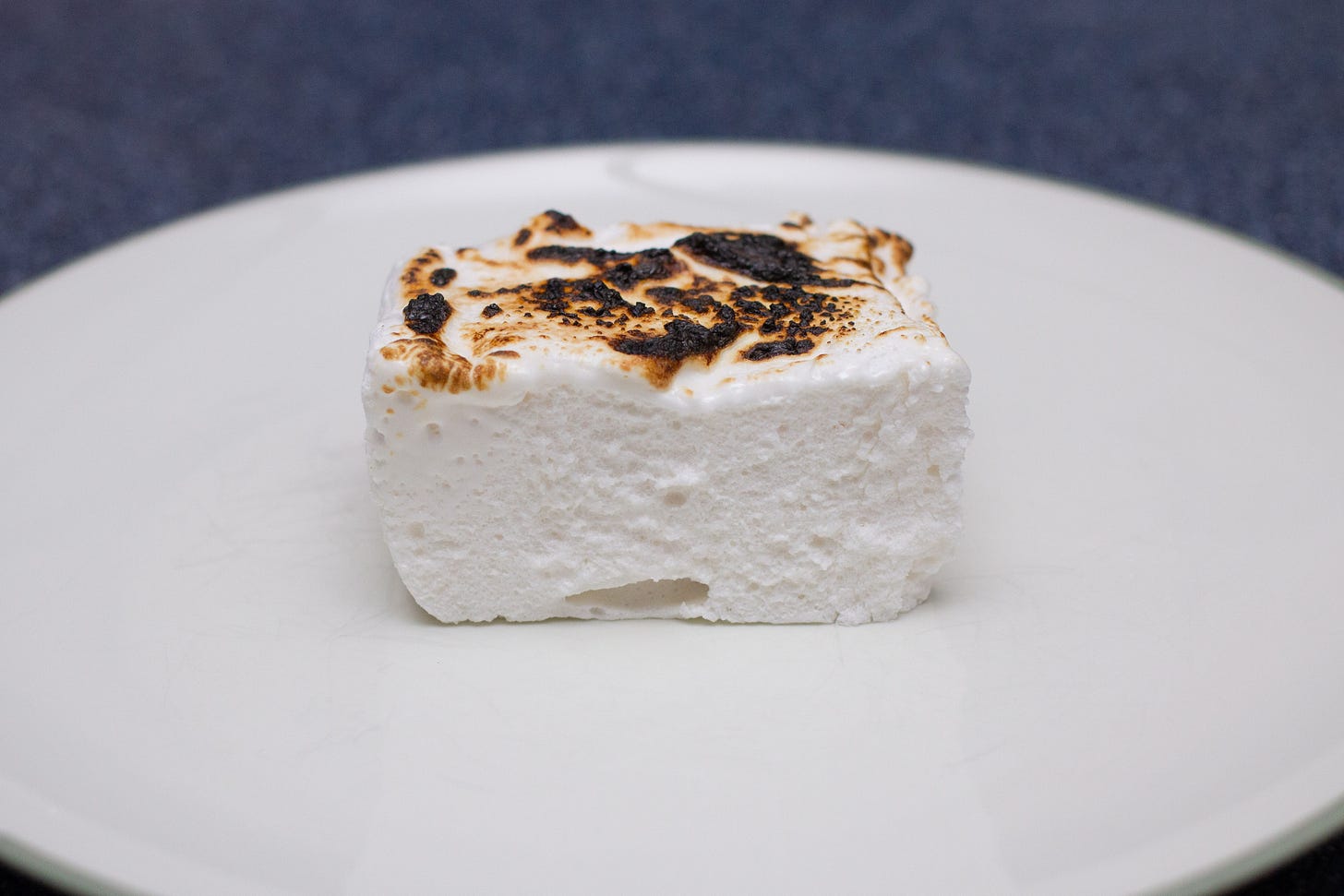Hot Chocolate and Homemade Vanilla Marshmallows
Confession: I tend to overthink things.
It’s another double recipe this week! Scroll below the hot chocolate recipe for the marshmallow one. Scroll below that to see the story.
Hot Chocolate Recipe
This is a thick, rich, European-style hot chocolate. The serving size is small (half a mug) to compensate.
Yield: 2 medium cups or 3 small ones
Time: 15 minutes
Ingredients
3.5 oz (100 grams) Guittard semi-sweet chocolate (baking bar or chips)
¾ c (190 g) whole milk
¼ c (65 g) heavy cream
¹⁄₁₆ tsp salt
Instructions
1. If you’re using a bar of chocolate, chop it into small pieces.
2. Place all the ingredients in a small pan.
3. Heat over medium low, whisking constantly, until the chocolate melts, everything emulsifies and turns a uniform dark brown color, and it begins to simmer (a few bubbles appear at the side of the pot).
4. Immediately and carefully, pour into 2 or 3 small mugs.
5. Enjoy! If you don’t finish it, you can refrigerate it and reheat in the microwave.
Notes and tips
Please use a good-quality chocolate. You don’t have to use Guittard, but it is smooth, makes a thick hot chocolate, and has a lovely balance of fruity and buttery flavors. It’s the best chocolate I could find that is widely available.
I developed this recipe for this specific brand of chocolate. If you use something else, adjust your ratios of milk and heavy cream to get a thick but drinkable cup.
If you love dark chocolate, feel free to substitute! Just add 2 tbsp sugar to tone down the extra bitterness.
I recommend a very small mug or an espresso cup for serving the hot chocolate.
Vanilla Marshmallows Recipe
These marshmallows are nothing like the ones in the grocery store. They are delicately springy, melt easily into a warm drink, and aren’t terribly sweet. The effort is worth it.
Yield: 6 large marshmallows
Time: 30 minutes plus 3 hours’ setting time
Ingredients
1 tbsp (7 g) powdered sugar
1 tbsp (7 g) cornstarch
1 packet (8 g or 2 tsp) gelatin
5 tbsp (75 g) water, divided
⅓ c (72 g) sugar
1 tbsp (20 g) corn syrup
1 egg white, at room temperature
⅛ tsp salt
½ tsp vanilla extract
Instructions
1. Stir the powdered sugar and cornstarch together in a small bowl. Use this mixture to thoroughly dust the bottom and sides of a small (1-lb) loaf pan.
2. Bloom the gelatin: Place 3 tbsp (45 g) water in a small bowl. Slowly and evenly sprinkle the gelatin on top and set aside for at least 10 minutes.
3. While the gelatin is blooming, place the granulated sugar, corn syrup, and remaining 2 tbsp (30 g) water in a small pot.
4. Place the egg white and salt in the bowl of a stand mixer fitted with the whisk attachment.
5. Alright, this part is a little tricky. You’re going to want to time things so that the egg whites are at stiff peak stage at the same time the sugar syrup is at 240°F. The egg whites can over-whip and dry out, and the sugar syrup gets too firm if it goes longer. It can take practice to time things right, so see the notes section for tips.
6. Heat the sugar and corn syrup over medium-low, stirring until the sugar is dissolved and the mixture starts bubbling. Once it begins bubbling, stop stirring.
7. Continue to cook the sugar mixture until it reaches 240°F. Use an instant-read thermometer to check.
8. Meanwhile, whip the egg whites on medium-low speed until broken up and a little foamy at the top.
9. Increase the mixer to medium speed and whip until the egg whites reach stiff peaks.
10. Once the egg white is at stiff peaks and the sugar mixture is at temperature, slowly pour the hot sugar syrup down the side of the mixing bowl in a thin stream. You want it to hit the bowl’s edge an inch or two above the top of the egg whites so the beater doesn’t spray hot sugar everywhere.
11. Increase the mixer speed to medium-high.
12. Scoop the bloomed gelatin into the pot you used to make the sugar mixture and swirl gently until completely melted.
13. Stream the gelatin into the mixer just like with the sugar syrup.
14. Whip the marshmallow on high speed until the mixing bowl feels lukewarm to the touch. Add the vanilla and mix until incorporated.
15. Scoop the marshmallow out into the prepared loaf pan, spreading it into the corners and smoothing it with a spatula.
16. Dust the top with the powdered sugar mixture and leave to set, uncovered, for 3 hours.
17. After the marshmallows have set, cut into rectangles and enjoy.
18. Extra marshmallows will keep, covered, at room temperature for a few days.
Notes and tips
Because of the meringue, these marshmallows are a trickier than recipes that use corn syrup as a base. But it’s worth the extra effort. The marshmallows turn out light and aren’t too sweet.
If you can’t be bothered to take your egg out of the fridge ahead of time, pour hot water in a bowl and submerge a whole egg, shell and all. Let it sit, and in 5 minutes it will be at perfect room temperature.
You want your gelatin to evenly absorb the water with no dry spots, so take your time when sprinkling. If you do have a dry spot when you’re done, add a little extra water (1 tsp).
To time things correctly, I start my mixer on low speed as soon as the sugar mixture is on the heat. By the time the egg whites are fully whipped, the sugar is at temperature. If things don’t feel like they’ll be ready on time to you, you can adjust the temperature of your stove up or down, decrease the speed of your mixer, or stop the mixer altogether for a short time. The main thing you don’t want to do is overbeat the egg whites (they’ll get very stiff and dry and clumpy) or overcook the sugar syrup (you’ll have hard marshmallows).
It’s easy to overcook the sugar syrup since we’re working in small quantities. Check temperature every minute or so after it reaches a rolling boil. To check the temperature, tilt the pot so the mixture flows to one side and made sure your thermometer doesn’t touch the bottom of the pot.
Stiff peaks mean when you take the whisk out of the mixing bowl, the egg white forms a little “peak” and the top doesn’t flop over.
Adding the vanilla at the end keeps the flavor from being cooked out by the hot sugar syrup.







The story
I stole this recipe idea from The Bent Spoon, a shop in downtown Princeton that sells ice cream in summer and incredible hot chocolate in winter. This stuff is thick, bitter, fruity, and complex all at once. It’s so rich you wonder if you’re drinking melted chocolate straight. Pair that with Bent Spoon’s house-made honey vanilla marshmallows, and you’re looking at heaven in a cup. The only problem is that heaven is expensive—$8.50 a pop.
I decided to make my own (more affordable) hot chocolate recipe, and I had a blast doing it. I made five batches, each with a different brand of chocolate, and asked my Bible study friends to come over and taste test. They did so with great enthusiasm. The actual recipe development part was blissful, too. I tweaked the amount of salt, added extra milk, and I was done.
But then I started thinking about it. Was posting this recipe ethical? Did it contradict my dogmatic belief that if one has the money and the time, one should support local businesses? And The Bent Spoon is a local business I support wholeheartedly. Their desserts are made from the highest quality ingredients, and what they do is art. Ice cream flavors range from run of the mill (mango and lavender mascarpone) to experimental (seaweed and pawpaw), and each flavor they make actually tastes like that thing. Making ice cream like this available in town instead of a Michelin-starred restaurant is a gift to humanity.
This is ridiculous, I told my brain. Sure, competing with The Bent Spoon wouldn’t be right. But I didn’t think my recipe would actually do that. Most locals pop in when they’re wandering the town, shopping the shops, or walking by after a meal, craving something sweet. They get the hot chocolate because it’s convenient and they want it when they’re out and about, not at home.
What about the out of towners? my brain whispered. I have two sets of friends who used to live here, and the last time they visited us, each couple (totally independently) asked to drive into town just to drink The Bent Spoon’s hot chocolate.
Not everyone lives near Princeton, I told my brain. And not everyone likes the hot chocolate at The Bent Spoon. It’s bitter and dark, and my recipe lets you adjust the type of chocolate and amount of sugar. I was catering to a different audience. That’s all well and good, my brain said, but the adjustability works for dark chocolate lovers, too.
And then it hit me. My blog doesn’t have thousands of subscribers. Even if I was trying, there was no way in the world I could put a small business out of business. See, brain? You were soooooo worked up and it was all for nothing.
What if your post goes viral? it whispered.
Spread the snob
If you like this recipe, please recommend Confessions of a Cake Snob to someone you know! Follow me on Pinterest or Instagram for more ways to view and save the recipes. Please share this newsletter with a friend, comment on the website, or bake it and let me know how it went for you! Email me with comments, ideas, and suggestions at confessionsofacakesnob@substack.com.




